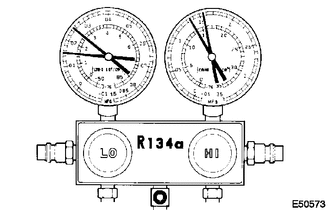- Receiver dryer oversaturated
- Moisture in refrigeration system freezes at expansion valve orifice and blocks refrigerant circulation
| Last Modified: 08-28-2024 | 6.11:8.1.0 | Doc ID: RM100000000VK1U |
| Model Year Start: 2016 | Model: Sienna | Prod Date Range: [12/2015 - ] |
| Title: HEATING / AIR CONDITIONING: REFRIGERANT: ON-VEHICLE INSPECTION; 2016 - 2020 MY Sienna [12/2015 - ] | ||
ON-VEHICLE INSPECTION
PROCEDURE
1. CHECK REFRIGERANT PRESSURE USING MANIFOLD GAUGE SET
(a) This is a method to identify trouble areas by using a manifold gauge set. Read the manifold gauge pressure under the following conditions.
Test conditions:
- Engine warm.
- All doors fully open.
- A/C switch is on.
- Blower speed control switch at HI.
- Engine running at 1500 rpm.
- Air inlet mode damper set at RECIRC.
- Temperature control switch in MAX. COLD position.
- Air temperature at air inlet 30 to 35°C (86 to 95°F).
|
(1) When the refrigerant volume is correct, the gauge reading indicates as follows: Gauge Reading:
HINT: Pressure varies in accordance with certain conditions (outside air temperature, sunlight and wind). |
|
(2) When there is moisture in the refrigeration system:

|
Symptom |
Probable Cause |
Diagnosis |
Corrective Action |
|---|---|---|---|
|
During operation, pressure on low pressure side cycles between normal and vacuum |
Moisture in refrigeration system freezes at expansion valve orifice, causing temporary interruption of cycle However, when melted, returns to normal condition |
|
|
(3) When cooling is insufficient:

|
Symptom |
Probable Cause |
Diagnosis |
Corrective Action |
|---|---|---|---|
|
Gas leakage from refrigeration system |
|
|
(4) When the circulation of the refrigerant is poor:

|
Symptom |
Probable Cause |
Diagnosis |
Corrective Action |
|---|---|---|---|
|
Refrigerant flow obstructed by dirt in condenser |
Condenser clogged |
Replace condenser |
(5) When the refrigerant does not circulate:

|
Symptom |
Probable Cause |
Diagnosis |
Corrective Action |
|---|---|---|---|
|
|
Refrigerant does not circulate |
|
(6) When the refrigerant is overcharged or cooling of condenser is insufficient:

|
Symptom |
Probable Cause |
Diagnosis |
Corrective Action |
|---|---|---|---|
|
|
|
|
(7) When there is air in the refrigeration system:

|
Symptom |
Probable Cause |
Diagnosis |
Corrective Action |
|---|---|---|---|
|
Air in refrigeration system |
|
|
(8) When the expansion valve malfunctions:

|
Symptom |
Probable Cause |
Diagnosis |
Corrective Action |
|---|---|---|---|
|
Expansion valve malfunction |
|
Replace expansion valve |
(9) When the compressor is defective:

|
Symptom |
Probable Cause |
Diagnosis |
Corrective Action |
|---|---|---|---|
|
Internal leakage in compressor |
|
Repair or replace compressor |
2. INSPECT IDLING SPEED
(a) Warm up the engine.
(b) Inspect idling speed when these conditions are established.
- Check the idle speed with the cooling fans off.
- Turn off all the electrical systems.
- When checking the idle speed, the transaxle should be in neutral or park.
Standard:
|
Condition |
Idling Speed |
|---|---|
|
A/C switch is off |
600 to 700 rpm |
|
A/C switch is on (A/C Lo → Hi) |
650 → 800 rpm |
If the idling speed is not as specified, check the idle control system.
|
|
|
